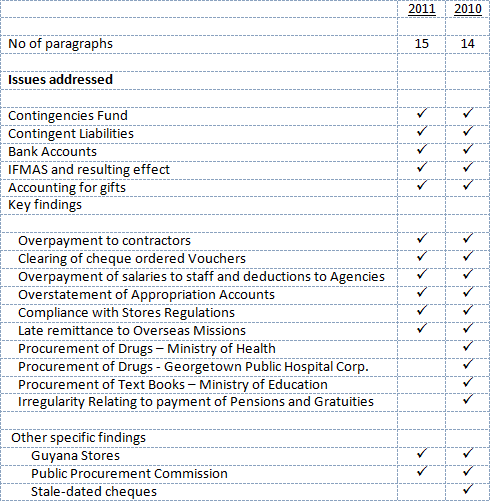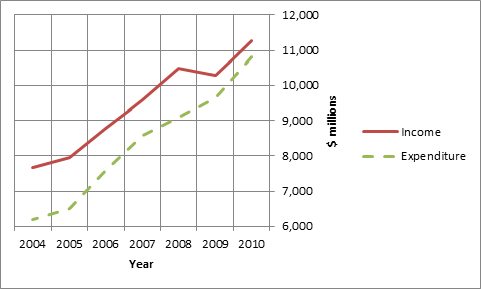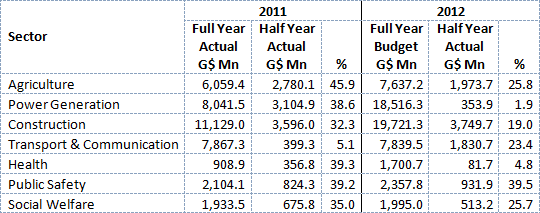Introduction
The 2011 Auditor General’s report is the earliest since 1993. It is also among the poorest in terms of quality and content. Those journalists who look forward to going to town on the report will be disappointed by the shortened and sanitized work produced by the national Audit Office. Indeed two days after the report was published it had ceased to attract media attention. The word “abuse” that described the management of the Contingencies Fund by the Minister of Finance has been replaced with more acceptable language “continued to be used without meeting the requisite criteria” – “urgent, unavoidable and unforeseen.” It is more than mind-boggling that Mr Sharma could think that expenditure related to the elections of November 28, 2011 could have been “unforeseen,” particularly since in a special report on advances to the police for the elections, Mr Sharma acknowledged that such advances were also a problem in 2001 and 2006.
Here are some other issues which have been highlighted in past audit reports which have been relegated to verbiage in the report itself, if they appeared at all: Procurement of drugs for the Ministry of Health and the Georgetown Public Hospital Corporation amounting to three billion dollars from New GPC; procurement of pirated textbooks by the Ministry of Education; fraudulent payment of pensions and gratuities; stale-dated cheques; lottery abuse; etc. And things that appear to have escaped attention were monies spent on Pradoville 2, contract employees, the severe weaknesses at NCN and failure to account for NICIL.
Once again the Audit Office fails to look into the annual sum of $100 million allocated to the Ministry of Culture, Youth and Sport for arts and sports development. Had it not been for the fact that this issue has been publicly raised on several occasions, I would have suggested that, bad as it is, the Audit Office is unaware of the existence of the Fund. That they must have been aware of it points to a more serious matter: that they are not keen in helping taxpayers’ knowledge of how the $100 million per year is spent, reportedly under the direction and control of no more than two individuals.
Not understanding the implications
Some time ago, in reviewing a special report of the payments of social security, I suggested quite strongly that the Auditor General does not seem to appreciate the implications of some of his own findings – or could not really care. Let us take as an example paragraph 11 of the report which states that, “The Ministry of Health failed to adhere to the provisions of Section 43 of the Fiscal Management and Accountability Act (FMAA), which requires any unexpended balance of public moneys issued out of the Consolidated Fund to be returned and surrendered to the Consolidated Fund at the end of each fiscal year.”
Now compare this with paragraph 65 of the report which tells taxpayers that “the Guyana Office for Investment (GO-INVEST), Environmental Protection Agency (EPA) and Institute of Applied Science and Technology (IAST) failed to make timely refunds of unspent balances as at 31 December 2011, which respectively, amounted to $20.598M, $223,730 and $1.794M. Since these refunds were paid to the Office of the President during the year 2012…”
At a time when the National Assembly had voted to reduce the allocation of that Office, a clear breach of the FMAA that puts money into the Office of the President rather than into the Consolidated Fund raises legitimate questions. Not only does the report leave it to the reader to wonder whether or not the money was paid back into the Fund, but there is nothing in the National Estimates to indicate how the money was eventually disposed of.
Contingencies Fund
Let us return to the Contingencies Fund, the sole responsibility for which lies with the Minister of Finance. We learn that he authorised eighty withdrawals from the Fund over a period of nine months, or an average of nine withdrawals per month. What the Audit Report does not acknowledge is that the Minister of Finance must report to the next sitting (emphasis mine) of the National Assembly on all advances made out of the Contingencies Fund, specifying (a) the amounts advanced; (b) to whom the amounts were paid; and (c) the purpose of the advances.
The Minister must also come by way of a supplementary appropriation act and for the replenishment of the Contingencies Fund. But so that the National Assembly is aware of the consequences of its decision, the FMAA imposes another requirement on the Minister: he has to state the reasons for the proposed variations and provide a supplementary document describing the impact that the variations, if approved, will have on the financial plan outlined in the annual budget.
The requirement for a supplementary document applies to all financial papers, whether for the replenishment of contingencies or for a variation of the budget. Yet, Dr Singh has never once produced a supplementary document to the National Assembly for any of more than fifteen supplementary appropriation bills or so that he has presented to the National Assembly. Regrettably the members of the National Assembly have failed to request of the Minister that he comply with the Act as a condition for granting him any money.
I have written the Speaker of the National Assembly and he has promised to address the omission with the Minister.
Poor Ramnarine
We can now turn to the special report into the $90.649 million paid from the Contingencies Fund for feeding the Police, which was released by the Ministry of Home Affairs prior to the circulation of the wider 2011 Auditor General report. The Audit Office appears to have exonerated Mr David Ramnarine Divisional Commander, but not before his career path was seriously obstructed at the instance of the Minister of Home Affairs.
Again, in a half-baked way, the special report fails to question or explain how public funds could find their way into the bank account of the Police Welfare Fund which is not a public fund, and therefore a breach of the FMAA. Nor does the report explain why the unspent balance of several millions was only refunded into the Consolidated Fund in March 2012. There is a strong and widely held suspicion that the refund would not have happened had the opposition not brought the matter to the attention to the public. The Audit report could therefore be seen to be something of an escape route – if not a cover-up – for wider and higher-up impropriety in the Police Force. The real issue was not Ramnarine – he was the scapegoat. The issue was about the arrangement that but for the intervention of the opposition, would have left taxpayers’ money with the Police Welfare Fund.
There is one final danger point about the Contingencies Fund which I have pointed out before, and which was borne out in this case. The Audit Office not only consistently fails to report on important non-compliance by the Minister with the requirements of the FMAA, but also fails to pursue the actual spending of the sums from the Contingencies Fund. Short of appointing a professionally qualified accountant to the position of Auditor General I see little prospect for better control and oversight of the Contingencies Fund.
A solution
The National Assembly needs to act in this matter. They can do so in two ways. The first is to reduce the amount of the Contingencies Fund which the PPP/C administration raised from $500,000 to what amounts to more than $3.5 billion. If the Minister must come to the next sitting of the National Assembly for reporting and replenishment then $3.5 billion is an extraordinary sum. Reducing the amount – which requires a small legislative change – will introduce some level of accountability and oversight and rein in the Minister of Finance who seems impatient to bring supplementary appropriation bills to the National Assembly prior to spending. The second is to remove the amendment to the Constitution (Prescribed Matters) Act and return to the age limit of 55 years. Now that all our MPs are trained in legislative drafting that should be a simple task.
The fact is that Mr Sharma cannot do a proper job, given his dependence on the Government for his continuance in that position.
Value for [whose] money and drugs
And while we have not moved off from special reports it may be convenient to refer to two Value for Money audits which Mr Sharma has been working on for three years and which according to the 2009 Audit Report were “expected to be completed before December 2010.” In 2012 we are assured that the Audit Office is in the “process of finalizing” these. What makes the inordinate delay in the completion of these of considerable concern is the importance and relevance of the subject-matters of the exercise: “A Review of the Operations of the National Board and National Procurement and Tender Administration” and “An Assessment of the Management and Control of Drugs and Medical Supplies at the Ministry of Health.”
The 2011 Audit Report advertises these “projects” as demonstrative of the Office’s “commitment in ensuring the provision of reports which will facilitate improvements in the operations of our clients.” The public would recall that the exercise was first announced three years ago and would be aware that since then expenditure on goods and services has increased from around $75 billion to $125 billion and that on capital projects has almost doubled, moving from $45 billion to $75 billion. To compound the matter, the procurement laws apply to state-owned entities and other statutory bodies which would add another several billions of dollars per annum in places like GuySuCo and GPL.
And what about the purchase of drugs? For the Georgetown Public Hospital Corporation, expenditure on drugs and medical supplies in 2011 was $1.620 billion, while for the Ministry of Health the expenditure was over $2.6 billion. Not surprisingly, the lion’s share of the expenditure went to the New GPC which is known to have strong government ties and which is usually advanced the money to finance the procurement and supply of the drugs.
With the Audit Office having such fancy names as a Value for Money Unit, a Forensic Unit and a Quality Assurance Unit, taxpayers would like it to move expeditiously on a thorough examination using business principles and practice of this generous arrangement which involves reported markups on the supplies that many would consider price-gouging. And as for procurement, there can hardly be any financial and corruption issue that deserves a higher priority.
Conclusion
There is one final point to note in today’s column, and that is in relation to the 2000 Series Bank Accounts held with the Bank of Guyana. Dr Goolsarran and I have drawn attention to the drawing down of some of these accounts without complying with the law and any proper accounting for some $30 billion. Not only does the 2011 Audit Report ignore responsible and reasonable calls for explanations, but the 2011 table of the balances in Static and Active accounts is either amateurishly prepared or deliberately set up to mislead the readers and the National Assembly. In a table that is designed to show movement over time one does not exclude balances in an earlier year because the balance no longer exists. In the column for the respective year the amount ought to be shown. So that in the 2007 and 2008 columns, the amounts of $4,410.3 million and $4,690.6 million should have read $7,591.3 million and $7,868.4 million respectively.
It is troubling when an audit report itself becomes suspect.
To be continued



